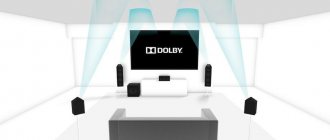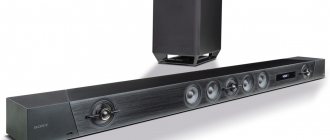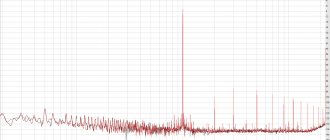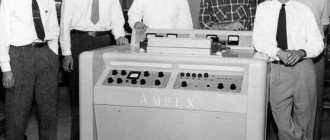So, what many were waiting for, and what many people doubted, happened - the Dune HD company released players with full support for Dolby Vision. So far there are only two of them, but we took the most sophisticated one for testing - Dune HD Max Vision 4K.
Why do we need a file player today when every TV already has a built-in one? There are several reasons for this. Firstly, external players, and this one in particular, have better playback quality. Our experience in testing TVs has clearly shown that media players built into TVs are always inferior to external media players in terms of video decoding quality. Why is that? It’s hard to say, but the fact remains: they generate more artifacts, they have worse detail, although, as a rule, they have better processors.
By default, the display of a player connected to the network shows the clock. The brightness of the glow is adjustable
Secondly, external players are more convenient and functional. They can play files from any server, not just DLNA, from hard drives and flash drives of any capacity, and more quickly when operating folders, but most importantly, they can play files of maximum quality - 4K, 3D images and simple Blu-ray discs, as well as DVDs , SACD and all other formats that are not available for built-in media players.
Thirdly, they output multi-channel audio of maximum quality. Most TVs don't have eARC, and those that do often have output limitations, such as Dolby Atmos when playing files or streams from on-line cinemas. DTS:X is generally supported by only a few. External players do not have such problems.
And fourthly, projectors need them. That is, if you want to get the highest quality image on a big screen, then you cannot do without an advanced media player with full support for Dolby Vision. The last condition is not a whim. It's not necessary because Dolby Vision is positioned as the best type of HDR video. Today it is no longer possible to do without its support, because most 4K releases on discs and in online cinemas are released with this encoding.
Two large antennas are for Wi-Fi, the small one in the middle is for Bluetooth. The third HDMI connector is an input for recording from external sources. HDCP does not work on it, but this is a feature of the platform
And they have been coming out for quite a long time, but until now there have been no adequate file players with its support - there were either disk players with limited functionality without support for online cinemas, like Oppo and its analogues, or with support for cinemas, but without the ability to play most files, like Apple TV.
Dune HD combines all of the above capabilities, except for the actual playback of optical discs, and we took the Max Vision 4K model for testing also because it has extraordinary sound capabilities.
The huge fan operates absolutely silently, producing a “voice” only for a second when the player is turned on
This is a full-fledged Hi-Fi player. And not only because of the characteristic design with a body 43 cm wide. Unlike, for example, the Dune HD Solo Vision 4K, which also received a Dolby license, it has a linear rather than switching power supply. It has different DACs from all other Dune players - AKM AK4493EQ. And finally, Max Vision 4K has balanced XLR outputs for outputting analog audio, which in fact do not look superfluous, given the specialization of the player itself, but more on this later, because the main thing about it is different.
Video first
Whatever one may say, Dune HD Max Vision 4K is first and foremost a video player, and not just a network player, but a file player, that is, capable of playing video from any media except optical media - over a network from any servers, from hard drives of all types and from external USB media, namely disks and flash drives with all common interfaces: USB 2.0, 3.0 and USB-C. This variety may seem unnecessary to fans of Smart TV and Apple TV, but in fact it is completely justified. This player is made for serious movie lovers. Many of them have accumulated different media over the years, each of them is accustomed to using certain ones, and in their own way. For example, depending on the situation, I use a server, large hard drives, and external ones with a USB interface.
By the way, the player actually has two bays for hard drives. On the front panel there is a slot for replaceable large 3.5-inch disks with the ability to be “hot” swapped without turning off the player. And on the back there is a twist-out tray for a 2.5 or 3.5-inch disk, as well as an SSD, which will be installed in the player permanently, for example, for torrents or a music collection of files.
conclusions
Perhaps the best file player today, combining full support for Dolby Vision, including in UHD Blu-ray images, with access to licensed content, ease of working with files and media, the best quality image scaling among all video devices and outstanding sound.
Advantages: full support for Dolby Vision, absolute omnivorous playback of various files, two HDMI outputs, a wide selection of connectors for connecting external media
Disadvantages: does not always work correctly with outdated video formats like DVD
Technical data Dune HD Max Vision 4K
- SoC: Realtek RTD1619DR
- CPU: 6-core ARM Cortex A55
- Video adapter: Mali-G51
- RAM: 4 GB
- Flash memory: 32 GB
- Video file formats: MKV, MPEG-TS, MPEG-PS, M2TS, VOB, AVI, MOV, MP4, QT, ASF, WMV, BD ISO, BDMV, DVD-ISO, VIDEO_TS
- Audio file formats: MP3, MPA, M4A, AAC, WAV, FLAC, Ogg/Vorbis, WavPack, APE (Monkey's Audio), ALAC (Apple lossless), SACD ISO, SACD DSF, SACD DFF, AC3, DTS, DTS-WAV
- Maximum video resolution: 3840x2160p60, 12 bit, 4:2:2
- Outputs: 1xHDMI v2.0, xHDMI v1.4 (for Audio), HDCP2.2, optical Tos-link (up to 24 bit / 96 kHz), coaxial digital RCA (up to 24 bit / 192 kHz), analog stereo RCA, analog balanced stereo XLR, composite video RCA
- Inputs: HDMI v2.0 without HDCP
- Interfaces: 1 x USB 3.1 Type A, 2 x USB 2.0 Type A, 1 x USB-C, Gigabit Ethernet, Wi-Fi 5 and 2.4 GHz, Bluetooth 4.0
- Dimensions: 430x80x310 mm
- Weight: 8.3 kg
Prepared based on materials from the magazine, April 2022
Return to list
The basis
Like last year's Dune HD Pro 4K II and recent Pro 4K Plus II models, this player is also built on the Realtek RTD1619 chipset, but the chip itself is special - RTD1619DR with a Dolby license, more expensive, and therefore this model is a little more expensive in in general.
The main difference is in the special original software (SDK), which allows this player to support the most difficult to decode 7th Dolby Vision profile, which in turn is used in UHD Blu-ray discs and images obtained from them.
The difficulty in decoding such images is that the actual 4K image is encoded in a single HDR10 encoded stream, and in addition to this, the image includes a second video track that contains dynamic Dolby Vision metadata and optional expansion of the base 10-bit video signal to 12-bit. bit. This additional data adjusts each individual frame of the film in accordance with the director's intent, ensuring optimal color rendition and brightness levels for all objects in each specific scene, making the picture as dynamic and beautiful as possible, but at the same time completely natural.
In addition, do not forget that the final image may be displayed differently depending on the availability and completeness of Dolby Vision support by the display device. To provide for all the options, the player has a whole separate section of settings dedicated to HDR video output.
UHD Blu-ray players do not have such subtleties, because there are initially fewer registered profiles - they are not designed to read the entire variety of files, so these files are processed somewhat more roughly. And the manufacturers of such players themselves believe that since there is no DV on the TV, then there is no demand from them. Dune HD Max Vision 4K is more versatile in this regard and, as a result, better in terms of obtaining images with a wide dynamic range.
It turned out to be quite easy to see how important all this is, without even resorting to a head-to-head comparison with players of previous generations. All Dune HD players (including this one) offer playback options when playing Blu-ray disc images: as a disc image, with a Lite menu, or by opening folders, streams.
Only the first option involves playback “in full” with the correction described above. The other two only play the main 4K video stream with HDR10.
Despite the fact that the TV or projector indicates that video with HDR is being displayed and the corresponding mode is turned on, the picture on the screen is not at all dynamic, but rather pale. Some TVs and even projectors can brighten up this situation by turning on tone mapping, which will make the picture quality relatively digestible, but without the bright highlights characteristic of HDR on polished objects and deep blacks in the shadows with detailed detail.
And only reproducing the complete image from DV returns it to its originally intended form. Moreover, on some films with DV, the director’s intention in some places begins to surprise, because the breadth of the dynamic range becomes greater than what is used to seeing.
The player itself shows posters, identifying the film by title
For example, the film Skyfall, seen many times, began to look more dramatic. Both in the cinema and when played on Oppo (there are no comparisons here), it looked generally quite bright. But with a full “reading” of his Dolby Vision range, the scenes at the beginning become deliberately pale, as if specially preparing the viewer for a sad outcome with Bond’s injury and oblivion, and the episodes in Shanghai, on the contrary, explode with colors and exemplary contrast - the work of the colorists is visible to the naked eye.
I am inclined to attribute such accuracy in working with such complex video to the greater processor power and new software of Max Vision 4K. In my opinion, they explain, without exaggeration, the excellent quality of upscaling any video to 4K. To be honest, I have never seen anything better on any TV or projector.
The player doesn’t seem to add anything on its own: it doesn’t try to artificially increase sharpness, deliberately outline the boundaries of objects, make colors better and cover up surfaces with grain and noise. The video just looks like it was transferred to 4K at the studio from the same transfer. At the same time, maximum quality is squeezed out of the original video, and there is absolutely nothing to complain about. Cartoons look just like perfect paintings - delight! And all this without the help of the notorious artificial intelligence.
And one more thing: the player’s powerful hardware performs well when navigating through files on disks and servers - compared to older models on other chips, everything just flies on this one, and the large volume of disks does not affect performance in any way. For comparison, Oppo does not accept disks larger than 2 TB at all, while Dune easily works with 10 TB.
Pro Vision 4K Solo Specifications
Price Pro Vision 4K Solo Currently (July 2021), the Dune HD Pro Vision 4K Solo media player can be purchased in Russian stores at a price of 40,000 rubles. In foreign online stores, the price of Pro Vision 4K Solo is $450.
Pro Vision 4K Solo Review Summary
In conclusion of the review of Pro Vision 4K Solo from Dune HD, let’s summarize what has been said.
What else, besides video and sound quality, does the Pro Vision 4K Solo TV box offer? There are many available applications, a very stable Wi-Fi connection, and an internal HDD bay. Also, let's not forget that the set includes 2 remote controls. Overall, I think Dune HD's Pro Vision 4K Solo delivers everything you could ask for in a media player. Dune HD Pro Vision 4K Solo review2021-07-25T14:32:12+03:00 SemenPlayers and devicesplayers Sooner or later, many users discover that the media player built into their LCD TV is either not powerful enough to play the entire 4K media library, or simply does not provide the best video quality. In this case, external media players come to the rescue. Dune HD is one of the leading companies in this market. Its models are equipped with…SemenSemen EditorUltraHD
And for music too
The player's sound deserves special mention. I repeat: it has different DACs and separate power supply for digital and analog lines. DACs have a different “piping”, namely the Comtrue CT7601PR asynchronous converter, which allows you to send a DSD stream not transformed into PCM, which in turn the DAC decodes natively (the player itself, by the way, easily works with SACD images, including multi-channel ones, and, naturally, supports all variety of audio formats from WAV to DFF). All this had a noticeable effect on the sound.
The analog part of the player is quite serious for a video device
If previous models simply produced an emphatically detailed sound with an emphasis on the upper mids, then this player can be called a music player. The sound is neutral, rather a little light and not at all tiring. This is not a high-end component, but it is certainly one of the most musical video cameras. Which, by the way, may soon become unique - according to information from the manufacturer, supplies of AKM chips may soon be interrupted, so Dune has already prepared a backup option based on ESS ES9038Q2M DACs of similar quality. So, if you want something exclusive, you should hurry up.
The player is also equipped with balanced outputs not because of its status, but because of the need to distribute signals between components with a minimum of losses, because such a player will occupy the main place in the DC system, and its analog outputs will need to be connected to another system with stereo components.
Large remote control with backlit buttons
I would like to use such an intricate scheme because Dune’s controls are very convenient. The player comes with two remote controls: a large one with IR control and a small teardrop-shaped one that works via Bluetooth. The first is equipped with backlighting and buttons for all occasions, the second is equipped with a microphone for voice search through Alexa.
However, to play music files and services, it is more convenient to use the proprietary Dune Control application for smartphones on iOS and Android. Not only does it actually completely replace remote controls - it immediately shows the contents of folders and disks, information about the file, it is more convenient for them to control playback, and indeed everything. Having installed it, after three minutes I simply put both standard remote controls aside and never touched them again.
In the end, I would like to especially emphasize what is usually said in reviews from the very beginning: Dune HD Max Vision 4K, like all modern players of the company, runs Android 9 OS with a proprietary shell, which not only expands customization options, but also very carefully disguises the system from Google. However, it does not reduce its capabilities at all - you can install any applications, in particular all video and music streaming services.
Let's say that the firmware immediately contains links (but not the applications themselves) to IVI, Okko and Netflix. All of them, of course, work, and titles with appropriate encoding on YouTube and Netflix are shown with HDR. That is, the player plays not only downloaded files, but also fully licensed content with DRM, which distinguishes it from players that sacrificed such things for the sake of compatibility with new standards.
SWITCHING CAPABILITIES
Both media players have three USB ports for connecting removable media storage devices, both are equipped with an audio and video interface HDMI1.3, component (Y-Pb-Pr) video output, an analog stereo pair, a LAN network connector, as well as optical and coaxial digital audio interfaces.
Now about the differences: iconBIT is equipped with an additional USB port for exchanging data with a computer. The port is useful when communication over the local network is limited for some reason, for example during intensive downloading from the Internet.
On the other hand, the Dune media player is equipped with a set of analogue 7.1 surround sound outputs, as well as composite and S-Video video outputs.
FUNCTIONS
Both media players support downloading information about films on Blu-ray from the Internet (BD-Live function) and implement functions for copying, deleting and editing data on removable media.
Thanks to an additional USB port, iconBIT media player provides the ability to copy media data from a computer without using the Network, which is an obvious advantage in cases where the wired network controller is busy with intensive downloading (and uploading, if downloading using a torrent client) from the Internet.
NETWORK OPPORTUNITIES
Both media players can be connected to a wired Ethernet 10/100 local network, and also functionally (both iconBIT and hardware) support wireless local networks.
Both Dune and iconBIT support network data exchange via the SMB and UPnP protocols, and thanks to the built-in torrent client, both media players can download media content from the Internet without using a computer.











